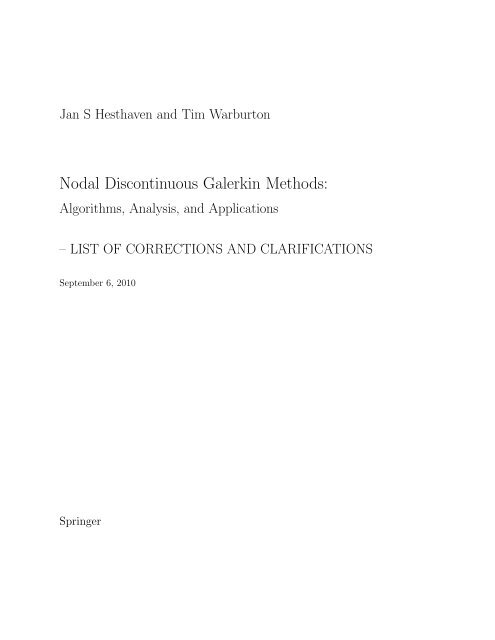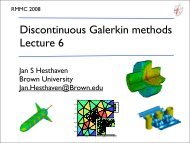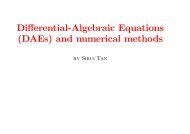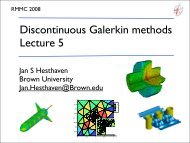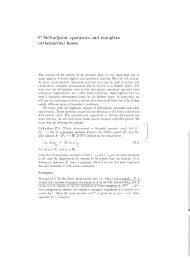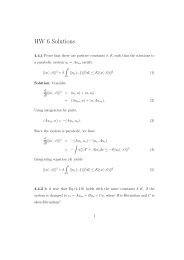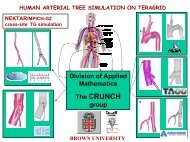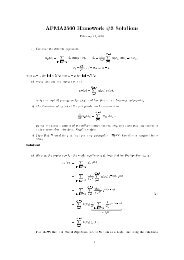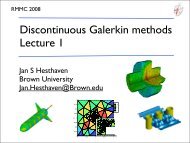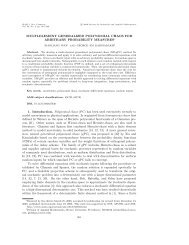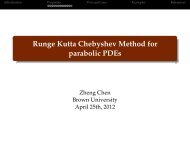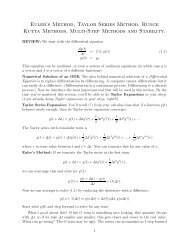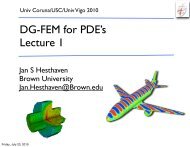Nodal Discontinuous Galerkin Methods:
Nodal Discontinuous Galerkin Methods:
Nodal Discontinuous Galerkin Methods:
Create successful ePaper yourself
Turn your PDF publications into a flip-book with our unique Google optimized e-Paper software.
Jan S Hesthaven and Tim Warburton<br />
<strong>Nodal</strong> <strong>Discontinuous</strong> <strong>Galerkin</strong> <strong>Methods</strong>:<br />
Algorithms, Analysis, and Applications<br />
– LIST OF CORRECTIONS AND CLARIFICATIONS<br />
September 6, 2010<br />
Springer
List of corrections and clarifications<br />
Notation: First number is page number, second number line number with a ”+” counting from the<br />
top and a ”-” counting from the bottom. Line counts include equations.<br />
Thanks to C. Bahls, A. Panizza, X. Zhu, C. Rohde, S. Field, J. Thorenson, J. Li, A.Engsig-<br />
Karup, A. Jameson, A. Kloeckner, M. Rosing for pointing out these misprints.<br />
12, 5 : ”noncoersive” should be ”noncoercive”<br />
45, -12 Should be dr and not dx in integral, i.e.,<br />
50, Eq.(3.3) : r i should be ξ i .<br />
50, -5 : Last expression should be<br />
∫ 1<br />
−1<br />
uv dr<br />
V ij = ˜P j−1 (r i ).<br />
56, 1 : To avoid confusion, l i (r), should be l(r).<br />
58, -1 : Matrix FToV should be<br />
⎡ ⎤<br />
1 0 0 0 0<br />
0 1 0 0 0<br />
0 1 0 0 0<br />
FToV =<br />
0 0 1 0 0<br />
0 0 1 0 0<br />
.<br />
⎢ 0 0 0 0 1<br />
⎥<br />
⎣ 0 0 0 0 1 ⎦<br />
0 0 0 1 0<br />
59, +3 : This also impacts (FToV)(FToV) T which becomes
4<br />
⎡<br />
⎤<br />
1 0 0 0 0 0 0 0<br />
0 1 1 0 0 0 0 0<br />
0 1 1 0 0 0 0 0<br />
(FToV)(FToV) T =<br />
0 0 0 1 1 0 0 0<br />
0 0 0 1 1 0 0 0<br />
.<br />
⎢ 0 0 0 0 0 1 1 0<br />
⎥<br />
⎣ 0 0 0 0 0 1 1 0 ⎦<br />
0 0 0 0 0 0 0 1<br />
This also implies that [59, +5] should read rows 1 and 8 indicate.<br />
67, 11 : MeshGen1D should be called with argument (0.0, 2 ∗ pi, 10).<br />
67, -2 : x ∈ [−2, 2] should be x ∈ [−1, 1].<br />
68, +2 : E(−2, 0) = E(2, 0) = 0 should be E(−1, t) = E(1, t) = 0.<br />
68, +15 : Should be<br />
= 1<br />
J k µ k . . .<br />
70,-7 : Software line<br />
[Nv, VX, K, EToV] = MeshGen1D(-2.0, 2.0, 80);<br />
should be<br />
[Nv, VX, K, EToV] = MeshGen1D(-1.0, 1.0, 80);<br />
71, -20 : Wrong exact solution. Should be<br />
[ ]<br />
H (m) (x, t) = n (m) A (m) exp(iωn (m) x) + B (m) exp(−iωn (m) x) exp(iωt)<br />
71, -18 : Wrong exact solution. Should be<br />
B (2) = exp(i2n (2) ω)A (2)<br />
71, -16 : Wrong exact solution. Should be<br />
A (2) = exp(−iω(n (1) + n (2) ))<br />
79, +13 : The expression for |ṽ n | is correct but it should be clarified by write it as.<br />
”We recover<br />
( ) p ∣∫<br />
1 ∣∣∣ |ṽ n | ≤<br />
(Lv) p ˜Pn (r) dr<br />
n(n + 1)<br />
∣ ,<br />
I<br />
by integration by parts 2p times. Recalling (4.2) and combining this with . . .”
5<br />
85, +17 : a(u x , v) Ω should be a(u x , φ) Ω<br />
87, +3 : ‖ε N ‖ 2 Ω,h should be ‖ε h‖ 2 Ω,h<br />
89, +16 : Should be<br />
[<br />
− iωh<br />
2 M + aS . . .<br />
has the meaning of the interpolation of the pro-<br />
109, last equation : Should be ν → 0 in lim.<br />
118, Sec 5.2 : Clarification: In this section, fh k<br />
jection of f, i.e.,<br />
N p<br />
∑<br />
fh k (x, t) = (P N f)(x i , t)l k i (x).<br />
This is equivalent to assuming that all integrals are exact.<br />
119, -8 : ”from” should be ”form”.<br />
122, +5 : Eq.(5.8) should be<br />
1 d<br />
2 dt ‖u h‖ 2 Ω,h ≤ 0.<br />
i=1<br />
123, -8 : Last expression should be<br />
N<br />
∑ p<br />
fh k (x, t) = fh k (x k i , t)l k i (x),<br />
i=1<br />
124, +3 : u k h (x i, t) should be u k h (xk i , t).<br />
130, +10 : Eq.(5.16), lower limit should be η c < η ≤ 1.<br />
134, -3 : The statement is only true for ˆn = 1. The general statement should be<br />
ˆn · (au) ∗ =<br />
2a+ a − (<br />
a + + a − {{u}} + 1 )<br />
2 [u]<br />
151, -9 : Should be<br />
ul = uh; ul(3:Np,:) =0; ul = V*ul;<br />
162,-1 to 163, +2 : Statements<br />
drho (mapI) = ...<br />
drhou(mapI) = ...<br />
dEner(mapI) = ...
6<br />
should be<br />
drhof (mapI) = ...<br />
drhouf(mapI) = ...<br />
dEnerf(mapI) = ...<br />
163, +6-8 : Statements<br />
drho (mapO) = ...<br />
drhou(mapO) = ...<br />
dEner(mapO) = ...<br />
should be<br />
drhof (mapO) = ...<br />
drhouf(mapO) = ...<br />
dEnerf(mapO) = ...<br />
165, +7-8 : The purpose of this piece of code is to describe initial conditions at the cell-centers<br />
as is required for discontinuous initial conditions. The correct statement should be<br />
cx = ones(Np,1)*(sum(MassMatrix*x,1))/2;<br />
If the initial conditions are smooth, cx, can be replaced by x in the codes in lines 9-11.<br />
175, +20ff : Should be ”Thus, w(r) is an N-th-order polynomial approximation to a function<br />
which measures the difference between the equidistant points and the Legendre-Gauss-Lobatto<br />
points; ...”<br />
179, -2 : Sixth number should be ”0.9808” - not ”0.9800”.<br />
182, +5 : Middle expression should be<br />
185, -2 : Should be<br />
194, +9 : ”each of length 3KN fp .<br />
195, +1 : Remove one ”find”.<br />
. . . V T l(r) = ψ(r) . . .<br />
S r = MD r , S s = MD s .<br />
206, -4 : Should be ”consider a diatomic gas with ...”<br />
208, 2 : Stabilization term (last term) should be<br />
209, -8 : Should be<br />
. . . + λ 2 (q− h − q+ h ).<br />
. . . x − x 0 − t<br />
,<br />
2π
7<br />
245, +9 : ”discretize” instead of ”discretizing”<br />
245, +19 : ”types” instead of ”type”<br />
246, +9 : Should be ”As in Section 5.3, we have ...”<br />
259, -3 : Exact solution should be<br />
268, +4 : Should be<br />
268, +8 : Equation (7.4)<br />
u(x, t) = cos(−π 3 t + πx).<br />
. . . + τ uk+1 h<br />
268, -5 : Equation (7.5) – same as above in (7.4).<br />
271, +3 : In caption – n should be N.<br />
. . . = hq k h.<br />
− 2u k h + uk−1 h<br />
h<br />
= . . . .<br />
282, -7/-8 : Should be ∂Ω D and ∂Ω N to reflect the boundaries.<br />
282, -2 : p O should be u D .<br />
287, -3 : Should be<br />
. . . = (f, φ) Ω , . . .<br />
287, 13 : Statement 48 in file should be A\(M*(-f(:)) + ubc);<br />
290, -3 Should be ”.. with π = ∇u we ”<br />
294, -8ff : Until p295, line 4, u h should be exchanged with P N u to avoid the confusion that u h is<br />
used for a numerical solution elsewhere. In these few lines, u h is the projection of the solution<br />
and these results are basic approximation results.<br />
294, -7 : Last term should be<br />
‖h −1/2 (u − u h )‖ 2 Γ b<br />
295, +14 : Remove one |u| Ω,σ,h .<br />
298, -10 : rhs should be f, i.e., >> f = f(P).<br />
312, -12 : ”compare” instead of ”compared”<br />
353, -19 : Remove ”which” to have ”spectrum and appears to be isolated.”<br />
373, +6 : ”complex situations.”<br />
376, -14 : Software statement, line 16. Should be
8<br />
theta1 = atan2(VY(v1)-yo, VX(v1)-xo);<br />
theta2 = atan2(VY(v2)-yo, VX(v2)-xo);<br />
399, -1 : ”information”<br />
413, -7 : Should be<br />
( √ √ )<br />
1 8<br />
. . . t 3,2 = −<br />
12 , −1 6 , ,<br />
9<br />
434, -4ff : The 6 equations are written with a wrong sign on the boundary flux terms. This is due<br />
to a definition of [q] = q + − q − which is inconsistent with the bottom of p.433.<br />
There should be a ’-’ in front of all boundary terms as a consequence of this.<br />
435-436 : This same inconsistency is reflected in the code which should be<br />
% form field differences at faces<br />
dHx(:) = Hx(vmapM)-Hx(vmapP); dEx(:) = Ex(vmapM)-Ex(vmapP);<br />
dHy(:) = Hy(vmapM)-Hy(vmapP); dEy(:) = Ey(vmapM)-Ey(vmapP);<br />
dHz(:) = Hz(vmapM)-Hz(vmapP); dEz(:) = Ez(vmapM)-Ez(vmapP);<br />
and<br />
fluxHx =<br />
fluxHy =<br />
fluxHz =<br />
fluxEx =<br />
fluxEy =<br />
fluxEz =<br />
ny.*dEz - nz.*dEy - alpha*(dHx - ndotdH.*nx);<br />
nz.*dEx - nx.*dEz - alpha*(dHy - ndotdH.*ny);<br />
nx.*dEy - ny.*dEx - alpha*(dHz - ndotdH.*nz);<br />
-ny.*dHz + nz.*dHy - alpha*(dEx - ndotdE.*nx);<br />
-nz.*dHx + nx.*dHz - alpha*(dEy - ndotdE.*ny);<br />
-nx.*dHy + ny.*dHx - alpha*(dEz - ndotdE.*nz);<br />
447, -9 : Software statement<br />
x(1) = (alpha-beta)/(alpha+beta+2);<br />
should be<br />
x(1) = -(alpha-beta)/(alpha+beta+2);<br />
420, -2 : Should be<br />
449, -1 : P (2i+2j+2,0)<br />
k<br />
S r = MD r , S s = MD s , S t = MD t .<br />
(b) should be P (2i+2j+2,0) (c)<br />
450, 2 : Second expression should be<br />
k<br />
. . . , b = 2 1 + s<br />
1 − t − 1, . . .<br />
459 : CorrectBCTable.m fails if an element has two faces on the boundary. An improved version<br />
but with a different calling sequence is
9<br />
function BCType = CorrectBCTable_v2(EToV,VX,VY,BCType,fd,BCcode)<br />
% function BCType = CorrectBCTable(EToV,BCType,fd,BCcode);<br />
% Purpose: Setup BCType for boundary conditions in 2D<br />
%<br />
% EToV : Element-To-Vertice table<br />
% VX, VY : (x,y)-coordinates of mesh vertices<br />
% BCType : Table with types of faces for BC’s<br />
% fd : handle to distance function<br />
% BCcode : Integer for specific boundary type<br />
%<br />
% By Allan P. Engsig-Karup<br />
Globals2D;<br />
VNUM = [1 2;2 3;3 1]; % face orientations<br />
pxc = 0.5*(VX(EToV)+VX(EToV(:,[2 3 1])));<br />
pyc = 0.5*(VY(EToV)+VY(EToV(:,[2 3 1])));<br />
dc = abs(fd([pxc(:) pyc(:)])); % distances to boundaries from face centers<br />
tol = 1e-4; % tolerance<br />
idx = find(dc


